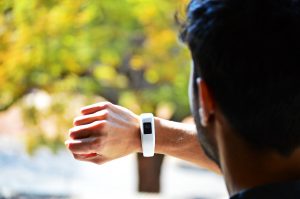Last updated 02-21-2020
By:
Natalya Bucuy
What does patient motivation look like?
“It would really help if you lost about 10-15 pounds, you know.” The doctor says to the thirty-something patient during a regular checkup.
“Yeah, yeah, I know, I will work on that,” the patient sighs, putting on his jacket, ready to sprint out of the office.
This is a scenario that plays out at all medical professionals’ offices everywhere, all the time. The chances of the patient actually following the doctor’s weight-loss advice are quite slim (pun intended). The same conversation would probably take place at the next checkup as well.
Ineffective patient motivation is a dangerous thing. Unhealthy lifestyles are a major problem in today’s society. According to one study from Michigan State University, only 3% of Americans maintain a healthy lifestyle. (Psychology Today)
But what if there was a better method for health professionals to motivate their patients to live better, healthier lifestyles?
Here are four ways to improve patient motivation techniques.
1. Motivational interviewing
The technique of motivational interviewing is a patient-centered method. The health professional encourages the patient to talk about their own desire to change, the reasons to change, and commitment to change. The technique revolves around listening more than talking on part of the health professional.
The process serves as a guide for patients to set goals and recognize the importance of wellness. The two-way conversation fosters patient motivation through self-reflection and goal-setting.
The process is twofold. The first goal is to increase the person’s motivation. The second is for the person to make the commitment to change. As opposed to simply stating a need or desire to change, hearing themselves express a commitment out loud has been shown to help improve a client’s ability to actually make those changes. (Psychology Today)
There are four steps to patient motivation through the interviewing method:
- Open-ended questioning.
- Affirmations, or feedback during different parts of the wellness journey.
- Reflective listening, or helping patients arrive at answers instead of prescribing a need for motivation.
- Summaries, or repeating back to patients the observations patients have made themselves. This will help reinforce motivation. (Patient Engagement Hit)
A study by Brad Lundahl and Brian Burke shows that “a large and expanding number of controlled research studies of MI have demonstrated that it is significantly (10–20%) more effective than no treatment. [It is] at least as effective as other viable treatments for a wide variety of problems ranging from substance use to reducing risky behaviors and increasing client engagement in treatment.” (Journal of Clinical Psychology, Vol. 65(11), 1232–1245 (2009))
2. Positive Messaging
It’s not a secret that humans respond better to positivity than to negativity.
Studies show that positivity “enhances mental abilities such as ‘creative thinking, cognitive flexibility, and the processing of information.’ The left prefrontal area of our brains, which lights up with activity when we’re in a positive mood, is also associated with reminding us of the good feelings we’ll have when we reach a long-term goal. (Buffer)
When it comes to healthy bodies, health professionals have a better chance of patient motivation if they use positive, encouraging, inspiring messages, rather than scare tactics.
According to the American Society of Nutrition, “non-stereotypical, positive media portrayals of obese and overweight individuals can effectively decrease weight-based stigma, while negative portrayals may even worsen the stigma. Further, gain-framed communications seem to be more effective than loss-framed communications in endorsing prevention behaviors. When the message is framed to stimulate core values, the persuasion factor increases, since the person is more likely to pay attention and accept the message.” (American Society of Nutrition)

3. Follow-Ups

Frequent follow-ups are one of the significant strategies for patient motivation. According to Annals of Family Medicine study, “top performers described having patients make frequent follow-up visits to support behavior change, so the patients would know they were supported and “the door is always open.” (Supporting Patient Behavioral Change)
The study sites two major purposes of follow-ups – celebration of successes and problem-solving. When doctors support patients in the their efforts, show care of the progress, and celebrate successes, patients feel more inclined to stick to their goals. Problem-solving follow-ups help patients identify obstacles to their goals, find solutions to overcome them, and continue the process instead of giving up.
Moreover, when patients feel that their healthcare provider genuinely cares about them, their patient experience satisfaction rises. Additionally, while learning about specific concerns of its patients a healthcare practice might discover some information that could lead to overall service improvements.
“One quarter (27%) of patients do not have a strong sense that their providers care about them as individuals. Nearly one in five patients (19%) are not positive that their providers are focused on improving their health. “(Televox)
Continuous engagement with patients can prove to be a challenging task. However, modern technology can serve as an aid in the process of improving patient motivation with follow-ups.
If prior to, during, or after an appointment with a doctor patients have the option of answering a few questions about their progress, they might share things that will help doctors with the follow-up process.
Doctors can use smart technology like feedback kiosks to collect information, organize it, and then develop a system that will ease the follow-up process. Creating a personal patient profile with individual information including patient goals, concerns, and progress can help health care providers improve patient motivation and overall patient experience.
4. Wearable Technology

The first pedometer appeared in Japan in the 1960s. Since then, wearable technology that aids health and activity tracking has been improving dramatically. From Fitbit activity tracker, to smartwatches, to fitness belts, the variety of wearable gadgets available now provides choices to health enthusiasts everywhere.
When health professionals encourage the use of wearable technology to their patients, they open up two avenues for patient motivation – the accountability of the patient and another source of patient data collection.
According to a study published in the Journal for Nurse Practitioners, “data from wearables can be used as a secondary diagnostic tool by providing data to track patient information over time. Users can see their data instantly and use this information to change their activities. They can also determine when to contact a nurse practitioner for further assessment.”
The study further concludes that wearable technology provides the “ability to help empower and emancipate patients and increase patient-centered care.”
While wearable technology can aid with patient motivation, it is up to the patient to do the heavy lifting. In other words, wearable technology cannot change one’s lifestyle, but it can help the motivation along.
Bottom Line
To create a meaningful experience for their patient, healthcare professionals can employ various methods of patient motivation. Motivational interviewing, positive messaging, follow-ups, and wearable technology all serve as great tools for patient support.
Patient motivation can help improve patients’ well-being and decrease the frequency of illnesses.
After all, an ounce of prevention is worth a pound of cure.

